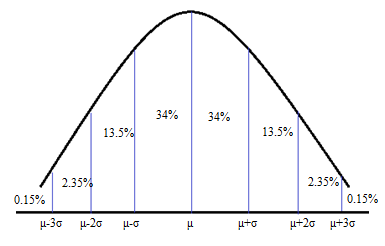
(a)
To calculate: The percentage of the 2015 ACT scores which are higher than 27.
The percentage of ACT scores higher than 27 is approximately is 16%.
Given:
The mean ACT Math score is 20.9.
The standard deviation of the ACT Math score
The distribution of the population of ACT Math scores is
Concept used:
In a normal distribution, the percentage of data within one standard deviation of the mean is about 68%, the percentage of data within two standard deviations of the mean is about 95%, and the percentage of data within three standard deviations of the mean is about 99.7%. The Z score of a data value is the number of standard deviations from the mean and is calculated using the formula
where

Calculation:
The given data point is 27 and its Z score is calculated as shown below
Approximately the score of 27 is one standard deviation more than the mean. With reference to the empirical rule, there is 68% of data within one standard deviation of the mean or there is 34% of the data between the mean and one standard deviation above the mean. Mean divides the entire data into two equal parts 50%, thus the percentage of data above 27 or above one standard deviation is
Conclusion:
The percentage of ACT Math scores higher than 27 is about 16%.
(b)
To calculate: The Math score needed to rank in the top 2.5% of all students who took the test.
The Math score needed to rank in the top 2.5% of all students who took the test is 32.9.
Calculation:
With reference to the normal curve and empirical rule, there is about 95% of data within two standard deviation of the mean and about 2.5% of data in each tail.
Thus top 2.5% of data will be over the two standard deviations above the mean and is calculated as shown below
Approximately the score of 32.9 is two standard deviations above the mean which has the top 2.5% of the students who took the test.
Conclusion:A score of 32.9 is needed to be the top 2.5% of all students who took the test.
(c)
To explain: Whether average ACT score of 50 states is a good estimate of the population mean ACT score.
The average of 50 states’ ACT scores is a good estimate of the population mean ACT score.
Concept used:According to central limit theorem irrespective of the distribution of population, the distribution of sample means will be approximately normal when the sample size is large (greater than 30). The mean of the sample is approximately considered the same as the population mean.
Interpretation:
With reference to the central limit theorem, as the number of states is 50, the sample size is considered to be large and the distribution of the sampling means is approximately normal. Thus the sample mean calculated by adding 50 states’ mean ACT scores and dividing by 50 will be a good estimate of the population mean ACT scores.
Chapter 10 Solutions
PRECALCULUS:GRAPHICAL,...-NASTA ED.
 Calculus: Early TranscendentalsCalculusISBN:9781285741550Author:James StewartPublisher:Cengage Learning
Calculus: Early TranscendentalsCalculusISBN:9781285741550Author:James StewartPublisher:Cengage Learning Thomas' Calculus (14th Edition)CalculusISBN:9780134438986Author:Joel R. Hass, Christopher E. Heil, Maurice D. WeirPublisher:PEARSON
Thomas' Calculus (14th Edition)CalculusISBN:9780134438986Author:Joel R. Hass, Christopher E. Heil, Maurice D. WeirPublisher:PEARSON Calculus: Early Transcendentals (3rd Edition)CalculusISBN:9780134763644Author:William L. Briggs, Lyle Cochran, Bernard Gillett, Eric SchulzPublisher:PEARSON
Calculus: Early Transcendentals (3rd Edition)CalculusISBN:9780134763644Author:William L. Briggs, Lyle Cochran, Bernard Gillett, Eric SchulzPublisher:PEARSON Calculus: Early TranscendentalsCalculusISBN:9781319050740Author:Jon Rogawski, Colin Adams, Robert FranzosaPublisher:W. H. Freeman
Calculus: Early TranscendentalsCalculusISBN:9781319050740Author:Jon Rogawski, Colin Adams, Robert FranzosaPublisher:W. H. Freeman
 Calculus: Early Transcendental FunctionsCalculusISBN:9781337552516Author:Ron Larson, Bruce H. EdwardsPublisher:Cengage Learning
Calculus: Early Transcendental FunctionsCalculusISBN:9781337552516Author:Ron Larson, Bruce H. EdwardsPublisher:Cengage Learning





